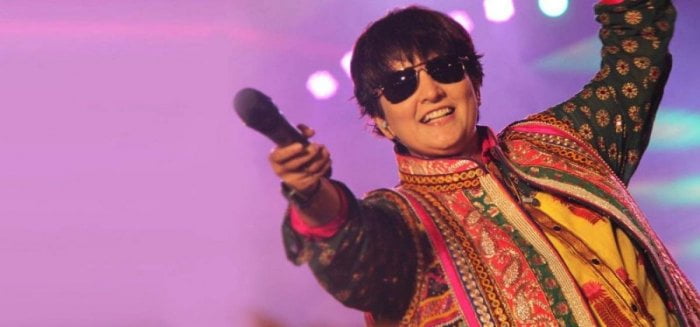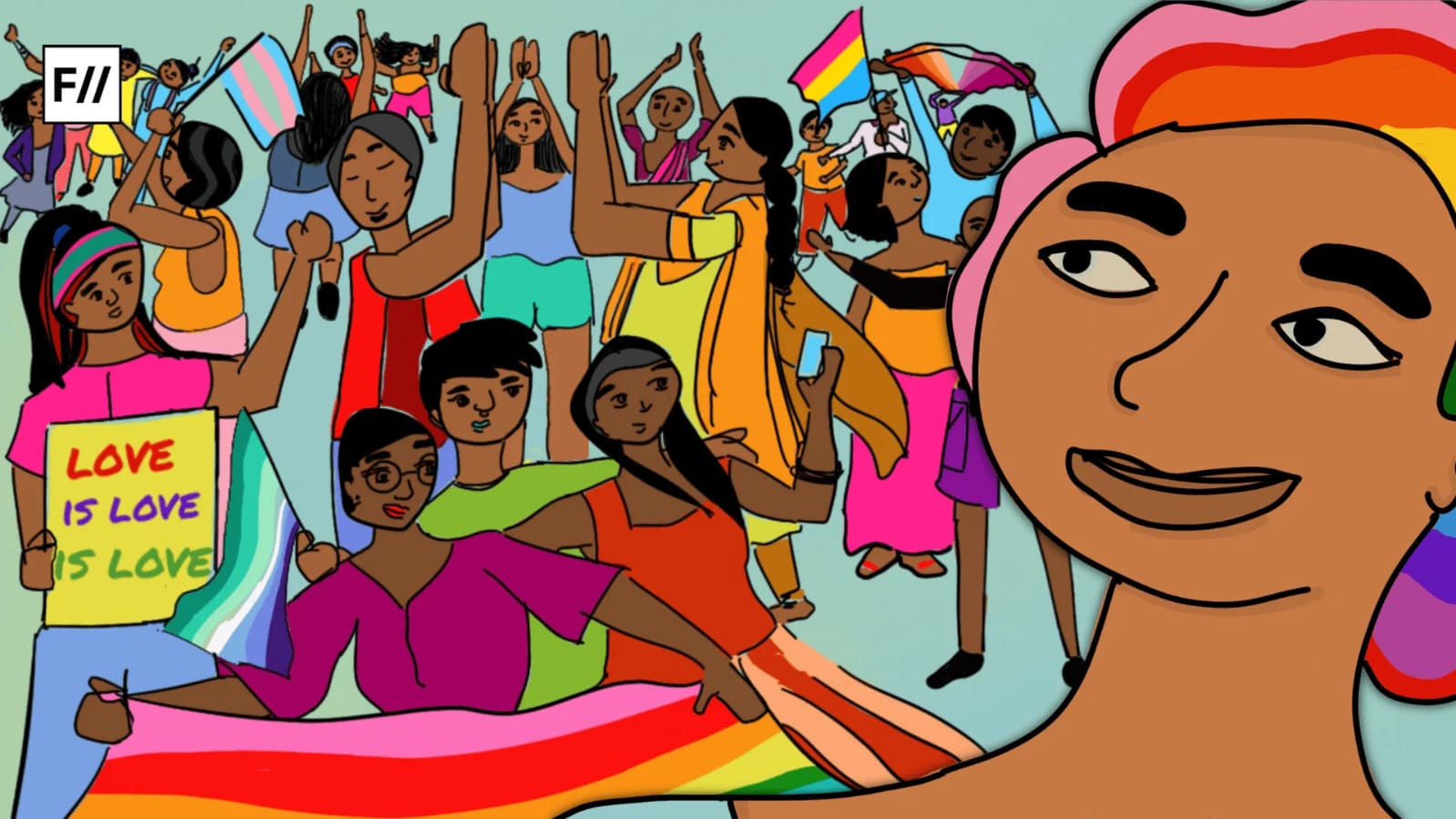The opening up of the Indian economy in 1991 brought a whole world of choices to our doorstep, especially for liberal women. We could now choose men from “Japan se leke Russia, Australia se leke America”. We didn’t even have to pick between chocolate, lime juice, ice cream and toffiyan – the ‘new woman’ could have it all.
Just when we thought the nineties had shown us every facet of femininity, from the lusty to the masti, Falguni Pathak fizzed onto the scene like a refreshing sip of Camp(a) Cola. With her floppy boy-cut, boxy jackets and virtuous high pitch, Falguni Pathak was the queer icon we didn’t know we needed. And if her personal style was my first encounter with androgyny, her music videos were my initiation into non-normative sexuality.
It all started in 1998, with the deceptively saccharine Yaad Piya Ki Aane Lagi, fondly known as Chudi. At first glance, the gaggle of girls in the music video seem to be India’s answer to Sex and the City, where Riya Sen, in true Carrie Bradshaw fashion, tries on outfit after outfit, only to reach her moment of high glory clad in a towel. But it soon becomes apparent that Riya’s sartorial zeal is not directed at any man, big or small.
Also read: Understanding Queer Fan-Fiction As The Site For Healing
Even though the male model in the video possesses all the essential 90s heartthrob qualities – such as a middle-parting, unsolicited advice and two shirts – he is ultimately irrelevant. The real hero, we know, is already centrestage. When I saw that first shot of Falguni, in her butch blue blazer, earnestly impersonating a cuckoo, I knew that life would never be the same again. And just like that, with a casual toss of her head, she inducted me/Riya into her gang of sapphic garba groupies, and we never looked back.
With her floppy boy-cut, boxy jackets and virtuous high pitch, Falguni Pathak was the queer icon we didn’t know we needed. And if her personal style was my first encounter with androgyny, her music videos were my initiation into non-normative sexuality.
Falguni’s celebrity continued to reign supreme in the rather mediocre Aiyyo Rama. This video offers a humdrum critique of the post-liberalisation era, where we learn that the materialistic world of malls and balls is all moh maya and that heterosexual pursuit is just an accidental, pesky and potentially life-threatening distraction from the real stuff of life (i.e. Falguni Pathak, in a brown blazer this time).
The most scathing commentary on heteropatriarchy, however, is reserved for one of her lesser-known masterpieces, Saawan Mein which exposes heteronormativity for what it really is – a needlessly aggressive and essentially misogynist low-stakes contest, where the odds are always stacked against the non-male identifying. Over the course of the video, the girls and boys compete in a series of frivolous battles, ranging from semi-stationary bicycling to ultimate embroidery. Obviously, Falguni wants to have nothing to do with this obnoxious display. She serenades from a safe distance as the escalating idiocy culminates in the simultaneous shattering of several large and fragile matkas, whose metaphoric resemblance to the male ego may or may not be purely co-incidental.
It is with the panache of those shattering matkas that Falguni Pathak breaks the fourth wall and descends from being our star to being our friend, in videos such as Maine Payal Hai Chhankayi, where Falguni, ever the puppet-master, choreographs an elaborate boy-meets-girl variety show, only to demonstrate its utter futility in everyday life. Her motley crew of artists suffer a series of unwitting and willful mishaps, including overflowing paint, overflowing Pepsi and overflowing cotton. The male-protagonist-turned-walking-Rorshach-test Vivaan Bhatena has little to offer in the face of these adversities, other than bonsai umbrellas and non-committal shrugs, but luckily our heroine finds a reliable support group in Falguni and friends.
The most scathing commentary on heteropatriarchy, however, is reserved for one of her lesser-known masterpieces, Saawan Mein which exposes heteronormativity for what it really is – a needlessly aggressive and essentially misogynist low-stakes contest, where the odds are always stacked against the non-male identifying.
Falguni’s generosity reaches its zenith in the outrageously campy Indhana Winva, where she mentors the girl next door into putting on a full-fledged drag show for the benefit of her unappreciative lover. With the help of her special queer powers, she conjures fabulous ensembles inspired by camp classics like the Lady Marmalade and genderqueer pharaohs. By the time the girl appears in a seemingly conservative ghagra-choli, we have been primed to understand that it is just yet another manifestation of her versatile, performative gender identity.
This subtle messaging may have been too ahead of its time to garner public attention. But in Meri Chunar Udd Udd Jaye, Falguni Pathak abandoned all ambiguity and gave us a queer love story for the ages, featuring a lovelorn Ayesha Takia, her estranged partner Falguni and their illustrious companion. The video begins like cliched fairytale, with an imprisoned heroine trapped in an impenetrable fortress controlled by a forbidding matriarch. The love triangle, however, is audacious and surprisingly tender.
The star-crossed lovers share a gentle, joyful relationship, full of laughter and avant-garde hand ballet. Even though it is hard to understand why they insist on wearing their shoes on their wrists, it is only natural to feel completely heartbroken at their separation. But right when we fear that all is lost, Ayesha finds a new confidante who literally comes out (of a painting) to her, offering her a listening ear and a dancing hand. In a refreshing change, the man in the video is not purely decorative but perhaps also a potentially powerful ally.
The same-sex subtext in Meri Chunar is obvious enough for it to have become a regular in listicles of the “Ten Times India was Accidentally Queer” variety; but with each of her offerings, Falguni Pathak gave us a vision of world where it was okay – even fun – for women to love other women, to imagine a life with them, and, most importantly to my preteen self, to openly desire them.
Also read: Film Review: Fire —On Queering Love And Beyond
We see that desire in Riya and co.’s hungry stares; we see it in the next-door neighbour’s impish appeals; but most of all we see it in Falguni herself, who receives and bestows attention with charming ease and somehow happens to be at all the right places at all the right times. With her sheer queer presence she disrupts the boringly linear logic of heteronormative encounters. Finding Falguni requires no once-upon-a-time-narratives or serendipitous meet-cutes; she is just there, always already known, and always already loved.
Sharvari is a researcher and teacher of theatre and performance with a passion for 90s popular culture and esoteric geography trivia. She currently lives and works between Chicago and Bombay. You can find her on her email: sharvari.sastry@gmail.com.
Featured Image Source: Deccan Herald





This is so exciting to read!! We often conflate the lack of visibility for the south asian queer community with the non-existence of the community itself here, but knowing an icon like Falguni Pathak flourished in 90s India is a relieving and reinvigorating. Keep bringing us more content like this!!
Even though I heard enjoyed listening to all these songs of Falguni in the 90s and thought she looked and acted boyish I missed this completely. Thanks for giving me a new insight. Probably true for most of us.
This is a wonderful piece! I was a young girl back then when these songs came out. While I was too young and naive to understand the nuances of the spectrum of sexualities that exist, I found it quite refreshing that a popular singer “normalized” the idea of girls loving girls.
Such a well written article! And yep, never knew / noticed this about her and the music videos at all. Thanks for this!